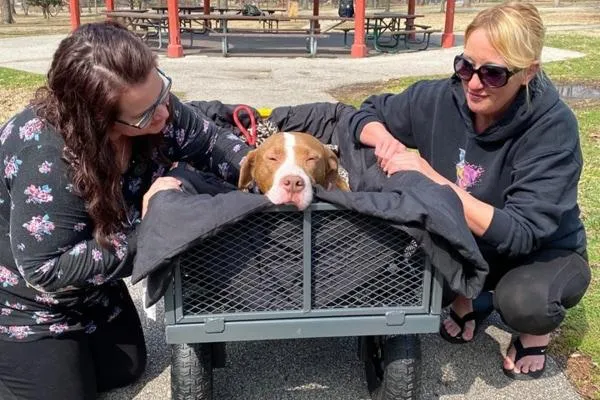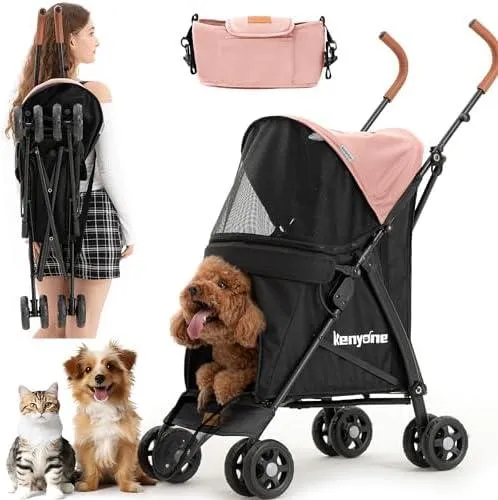The Complete Guide to Buying and Using a Dog Stroller
If you have an elderly, small, or disabled dog, taking them on walks can be challenging. A dog stroller makes it possible to bring Fido along without overexerting him. But choosing the right stroller and using it properly is important. In this article, I’ll answer all your questions about dog strollers—from what features to look for to tips for keeping your pup happy and comfortable.
Why Use a Dog Stroller?
Dog strollers offer several advantages over carrying or letting a dog walk on their own:
- Convenience – Strollers allow you to bring your dog places they otherwise couldn’t go, like long hikes or places where they must stay leashed.
- Comfort – Pups ride in comfort without stress on their joints. This is ideal for small dogs, seniors, or those recovering from injury.
- Safety – Your dog can’t suddenly run off or get distracted. Strollers also protect them from dangers like insects, hazardous terrain, or hot asphalt.
Choosing the Right Stroller
With so many dog stroller options, finding the right one can be overwhelming. Here are the most important factors to consider:
Size & Weight Limit
Measure your dog and check the stated weight limits—don’t squeeze Fido into a too-small stroller. Look for generous head/leg room. Expandable strollers accommodate growing pups.
Wheels & Terrain
Pneumatic wheels work well for pavement but knobby all-terrain wheels are best for hiking trails. Front wheels that swivel 360° make tight turns simple. Consider wheel size—larger wheels glide smoother over bumps.

Comfort & Safety
Padding, canopy, safety harness, toys, and water bottle cup holder keep your pup enjoying the ride. Mesh pockets, storage bins, and leash ports are handy. Reflective strips boost visibility in low light.
Collapsibility
Folding strollers pack small for transport—handy for cars or airline travel. Look for one-hand quick-release folding mechanisms.
Budget
Quality strollers range from $100-400. Consider long-term durability versus a lower initial cost. Safety should be the priority over minor conveniences.
Real-Life Example
When my chihuahua Oreo’s arthritis worsened, I bought the Pet Gear SUV Pet Stroller. Its large wheels glide smoothly and the extendable canopy kept her comfortable on our 6-mile hikes. She loves watching the scenery go by. The roomy interior and safety harness reassured me she was secure.
Using Your Stroller Safely
Once you have the right stroller, there are a few tips for keeping Fido safe and happy:

- Introduce the stroller positively with treats so your dog associates it with good things.
- Secure the safety harness—don’t rely on the canopy alone. Adjust it snugly without being too tight.
- Go slowly at first and let your pup get used to new sensations like bumps and turns. Avoid sudden movements that may scare them.
- Bring water, toys or chews to keep them occupied.
- Keep stroller well-ventilated on hot days with the canopy partially open.
- Consider marking the stroller for visibility if left unattended.
Dealing with Unexpected Situations
Even with training, your pup may get spooked by unexpected noises or people. Here are some tips for calming them:
- Speak in a soothing tone and give treats or praise when they settle.
- Consider anxiety wraps or calming vest to help them feel snug and secure.
- Bring calming chews containing ingredients like chamomile or L-theanine.
- Give them something to focus on, like a toy or activity book.
- Try a calming pheromone diffuser or spray on the stroller canopy fabric.
With time and positive reinforcement, most dogs adjust well to stroller rides. Be patient—move at their pace.
Regular Cleaning and Maintenance
To maximize your stroller’s lifespan, do basic cleaning and checks regularly:
- Wipe down fabric parts with a mild detergent and water solution.
- Lubricate wheels, locks, and pivots with a dry silicone spray.
- Inspect straps for wear—replace if frayed.
- Tighten bolts, nuts, or screws that may loosen over time.
- Wipe or hose mud and dirt from wheels and undercarriage.
- Store stroller in a cool, dry place when not in use.
With the right preparation and maintenance, your furry friend can enjoy stroller rides for years to come!
Frequently Asked Questions
Here are answers to some other common dog stroller questions:

Is my small dog too big for a stroller?
Even smaller dogs can benefit from strollers on long walks. As long as there’s enough head/leg room, don’t rule it out.
Won’t my dog overheatinside a stroller?
On hot days, partially open the canopy to let air circulate. Consider adding a cooling pad or bring bottled water. Avoid direct sun exposure.
Will other dogs think it’s weird?
Most dogs don’t care! They may be curious at first but won’t hesitate to play or socialize normally.
What if my dog refuses to get in?
Start desensitization training indoors with treats. Go slow and end sessions on a positive note. Keep trying—most dogs adapt once they realize it means fun walks!
Any other tips?
Consider car seat adapters if you travel by vehicle. Strollers provide an ideal way for disabled owners to exercise their dogs, too. The benefits are endless!

I hope this guide has answered all your questions about dog strollers. Don’t hesitate to contact me if you need any other advice!
Choosing the Right Dog Stroller
| Feature | Considerations |
|---|---|
| Size | Choose a size that can comfortably fit your dog. Measure your dog from head to tail and consider future growth if they are still young. |
| Weight limit | Check the weight limit and make sure it can support your dog’s weight and leave room for additional cargo like a blanket or toys. |
| Wheels | Larger wheels work best for uneven surfaces while smaller wheels are better for indoor use. Inflated tires provide a smoother ride. |
| Handles | Look for padded, adjustable handles at a comfortable height for your height and preference for pushing or pulling. |
| Safety features | Five-point harnesses, protective canopies, and reflective strips help keep your dog safe and secure. |
FAQ
- What is a dog stroller? A dog stroller is sorta like a baby stroller for dogs. It lets you take your puppy places while keeping them comfortable and safe.
- Why buy a dog stroller? There are a few good reasons to get a stroller. It allows elderly or injured dogs to join you on walks when they might not be up for lots of walking. Strollers also work amazingly for puppies that tire out fast. Plus, strollers keep your dog contained so they don’t run off unexpectedly.
- What features should I look for? When shopping for a stroller, look for one with decent wheels that’ll roll smoothly over different terrain. Storage is also nice to have below for toys, poop bags, water, etc. Canopy coverage against the sun is a must, as is safety restraints to keep pup secure.
- How much should I spend? Decent dog strollers range from $50 to $200 typically. Cheaper ones may be less durable or lacking features. Spend a bit more for lightweight aluminum frames, large wheels, and extra pockets. Don’t go too low or the quality might be kinda iffy.
- How do I introduce my dog to the stroller? Go slow when first introducing pup to the stroller. Let them sniff it without getting in at first. Give treats near it to build positive association. Then use high value treats inside to lure them in calmly. Keep initial rides around the house short before heading outdoors.
- Any tips for using a dog stroller? Practice basic commands like “stay” before and after rides. Secure all safety straps snugly. Bring water and take breaks if pup seems restless. Consider a reflective safety vest too for low light trips. Wipe down the stroller after muddy walks.
By the way, does anyone remember that time I took Ralph out in his stroller and the handle broke off all of a sudden? Man, that was a crazy day! Ralph went bouncing down the road like a furry tennis ball. Thankfully some nice joggers stopped to help wrangle him. I still haven’t lived that one down with my friends, if you know what I mean! They’re always bringing it up and teasing me about my “rocket dog.” Nevertheless, dog strollers can be totally worth it despite the odd mishap now and then.
